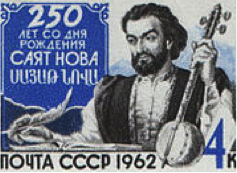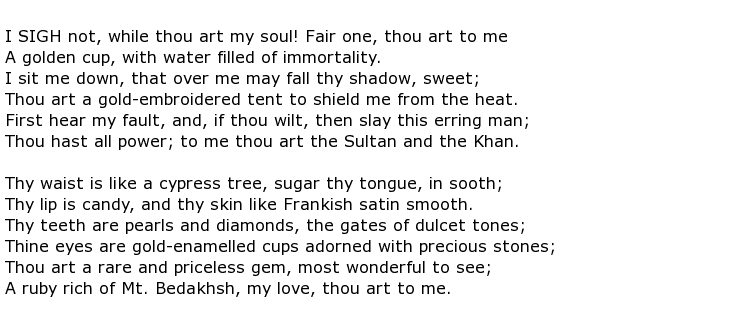 Sayat-Nova was an 18th century Georgian/Armenian poet, musician and sometime royal court diplomat. He entertained courtiers for a while before falling out of favour and then lived the life of the wandering minstrel (local term – ashik). Later in his life he became an apostolic priest in Armenia which was, at that time, a deeply religious country.
Sayat-Nova was an 18th century Georgian/Armenian poet, musician and sometime royal court diplomat. He entertained courtiers for a while before falling out of favour and then lived the life of the wandering minstrel (local term – ashik). Later in his life he became an apostolic priest in Armenia which was, at that time, a deeply religious country.
Records suggest that he was born Harutyun Sayatyan in June 1712, in the Georgian city of Tbilisi, which was also the birthplace of his mother Sara. His father was called Karapet and may have had Syrian or Turkish roots though this is not certain. He adopted the nickname Sayat-Nova and grew up writing and speaking the language of his mother and was soon exhibiting great skills as a writer, singer and musician. He learned to play a variety of stringed instruments such as the Persian kamancheh, the Georgian choghur and the Turkish tambur. He was also a talented writer of music and eventually wrote songs and poems in a number of different languages including Armenian.
His abilities were recognised by the ruler of Georgia, Erekle II, and he entertained courtiers daily. He was also granted diplomatic status and it is believed that his skills in that line were utilised during the formation of an alliance between the countries of Shirvan, Armenia and Georgia against the threat posed by the much larger Persian Empire. Sayat-Nova was, though, more artist than politician and he let his heart rule his head when forging an alliance of his own. He fell in love with the sister of King Erekle and was summarily banished from court.
To prevent any further recriminations he wisely chose to take to the road as an ashik, singing and playing traditional Georgian and Armenian folk songs wherever he went. He married and his wife Marmar bore him four children but she died in 1768. In 1759, at the age of 47, he took holy orders within the Armenian Apostolic Church and he remained a priest for the rest of his life. He had ministries in several locations including Tbilisi and at a monastery in the northern Armenian town of Haghpat. Unfortunately it was here that he met a violent death in 1795.
History shows that Sayat-Nova was a hugely influential poet and musician throughout Armenia. Even though he spent most of his life in a society steeped in religious fervour he wrote in a romantic style, never afraid to express his true feelings about love and life. He never allowed religion to influence his work in any way with most of his poems and compositions being very much of a secular nature. A good example is the poem simply called Love Song and the first two verses are reproduced here:

At least 220 songs are known to have come from his pen but it is very likely that he wrote many more. They were mostly written in the traditional Armenian style, in a variety of languages including Persian, Georgian and Armenian.
Sayat-Nova was killed in September 1795 at the Haghpat monastery by soldiers who were part of the invading armies of the Shah of Iran. He was 82 years old and his body was interred at the Cathedral of Saint George in Tbilisi.

